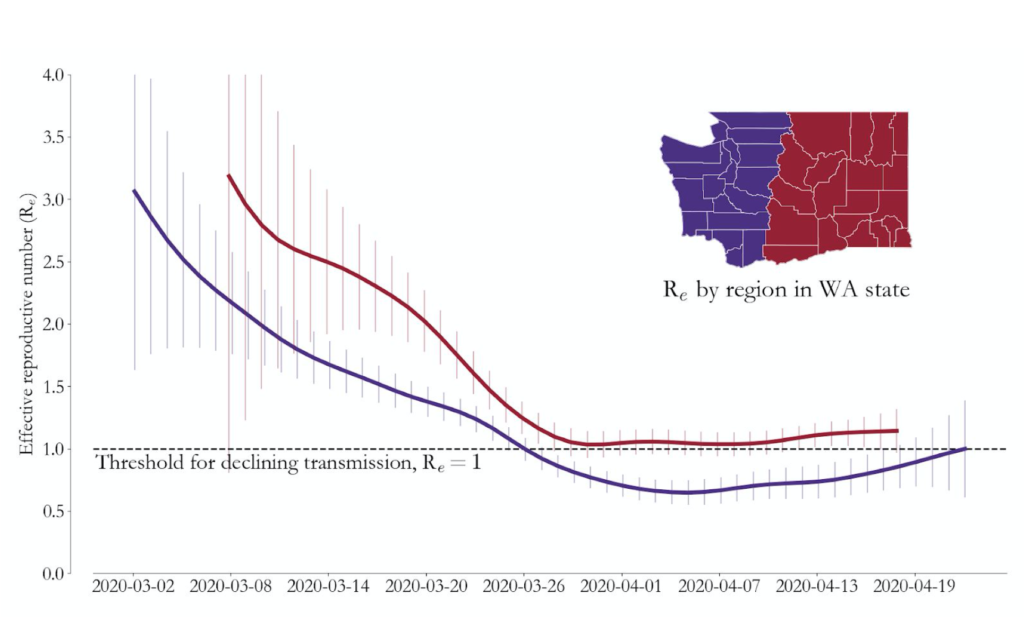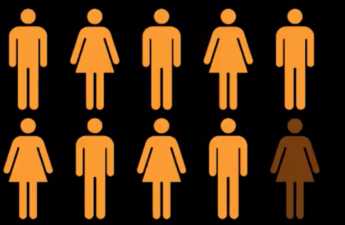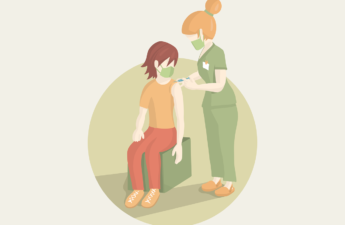
Latest report shows COVID-19 transmission rate may be increasing in King County and Western Washington; persisting higher in Eastern Washington
After dropping throughout March and into the first part of April, the transmission rate of COVID-19 is no longer falling and may be rising again in Western Washington, according to the latest report from Bellevue-based Institute for Disease Modeling (IDM).
The report also included an analysis of the rate of transmission in the eastern half of the state, finding it was persistently higher than in the western half.
The previous report last week found that the effective reproductive number—the number of new cases stemming from each COVID-19 infection—had dropped below the critical threshold of 1 in King County between March 29 and April 15.
However, updated case and mortality data from the Washington Disease Reporting System revised that estimate upwards, showing the reproductive number had no longer been falling and likely has been creeping up again since roughly April 6. As of April 22, the number in King County is between 0.47 and 1.32 (best estimate 0.89).
Overall in Western Washington, the reproductive number on April 22 was between 0.61 and 1.39 (best estimate 1.0). No longer definitely below 1, cases in Western Washington can be expected to plateau or increase if the trend continues.
The situation in Eastern Washington
This is the first report from IDM to include an analysis of COVID-19 transmission east of the Cascades. The transmission rate was slower to change and was persistently higher in the eastern half of the state. IDM estimates that the reproductive number has not dropped below 1 at any time through April 18, at which the reproductive number was between 0.96 and 1.32 (best estimate 1.14).
Barring recent and unexpected improvements we cannot yet observe, cases of COVID-19 are expected to increase throughout the region.
This latest report also compared traffic volume data from the Washington State Department of Transportation for King and Spokane counties. Relative to traffic in 2019 across the same period, traffic volume decreased in both counties throughout March but has been steadily increasing since early April.
As seen with transmission, changes in traffic volume are lagged by a week in Eastern Washington compared to Western Washington and not as strong relative to baseline last year.
Seeing similar coarse trends in traffic and COVID-19 transmission patterns increases confidence in the estimates of the reproductive numbers.
Physical distancing remains our best tool for reducing COVID-19 transmission. Because most of the population remains susceptible across the state, relaxing distancing policies will likely result in increased transmission.
However, our ability to measure these increases are retrospective, delayed by weeks due to both the time until symptom onset and delays in case reporting. To prevent a rebound in transmission, we must react quickly when data shows increases in transmission.
“It’s clear that the course of the epidemic in Washington remains sensitive to changes in social distancing,” said Dr. Mike Famulare, Principal Research Scientist at IDM. “We all—scientists, policymakers, everyone in Washington—face a difficult challenge in the coming weeks as our day-to-day lives will be in flux as we are forced to respond quickly to slow transmission and save lives.”
“This report once again reminds us that our position is precarious and COVID-19 transmission and new cases remain unacceptably high. We need to double down on distancing and other prevention steps at home, in the community, and in workplaces and we must see these numbers improve before relaxing our current restrictions,” said Dr. Jeff Duchin, Health Officer for Public Health – Seattle & King County.
Report link:
IDM shapes global efforts to eradicate infectious diseases and to achieve permanent improvements in the health of those most in need. An institute within the Global Good Fund, IDM is a collaboration between Intellectual Ventures and Bill and Melinda Gates. IDM is contributing modeling and analytic services to local and state governments to support COVID-19 response efforts.
Originally published on May 8, 2020


